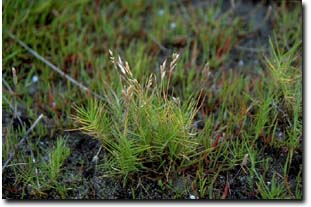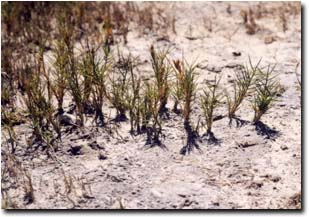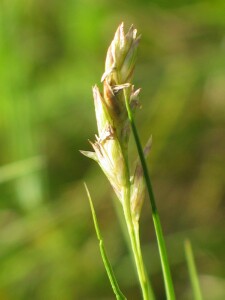Australian Salt-grass
Back | Salinity Indicator Plants Home | Common name home | Scientific name home | Photo Gallery | Glossary
| Australian Salt-grass Photos | Family: Grass (Poaceae syn. Gramineae) |
| Scientific Name: | Distichlis distichophylla |  Australian Salt-grass - plant with spikelets Photo: ex-Matters & Bozon | |||||||||
| Emu Grass, Pineapple Grass | ||||||||||
|
| ||||||||||
| Perennial grass, with closely bunched stems ascending from stolons or rhizomes and often forming dense mats where water is abundant. Leaves to 5 cm long, narrow (to 4 mm wide), strongly incurved, sharply pointed and regularly spaced, in two rows on opposite sides of the stem, resembling the ribs of a fish. The flower-head is usually a group of 2-5 (sometimes up to 10) pale spikelets at the end of a stem. Each spikelet is flattened and consists of 6-14 florets. Flowers mainly in spring but may continue into summer. | ||||||||||
Habitat: | Occurs in a wide range of soil types from sandy to loams and clays. Tolerant of periodically flooded or very wet soils.
| ||||||||||
Comments: | Quite a common plant in some areas especially in coastal areas and salt marshes. Sometimes forms quite dense mats in moderately saline areas. Useful for stabilising saline soils. Perennial grass, which often has closely bunched stems and leaves. The stems lie along the ground or ascend from rhizomes. The spikelets are flattened and have 6-14 individual flowers. Another Salt-grass species, that has been tested in an occasional Australian salinity trial as the cultivar ‘NyPa ForageTM’, is Seashore Salt-grass, Desert Salt-grass or Inland Salt-grass (Distichlis spicata syn. D. stricta or D. spicata var. stricta), a native to the Americas. It differs from Australian Salt-grass in having longer leaves (up to 12 cm) and generally larger flower-heads with up to 20 spikelets. Australian Salt-grass be confused with Couch Grass (Cynodon dactylon), Salt Couch (Sporobolus virginicus) and Rat's-tail Couch (Sporobolus mitchellii) in its creeping growth habit and leaf appearance but the couch grasses have very different flower-heads. The leaves of Couch Grass and Rat’s-tail Couch are generally duller or greyer green, are not as stiff and although pointed at the tips, are blunter than Salt Couch and Australian Salt-grass. The leaves of Salt Couch are not as regularly spaced as Australian Salt-grass and although sharply pointed, not as ‘prickly’. The ligule of Couch Grass is a ciliate membranous rim, while that of Salt Couch and Rat’s-tail Couch consists of a row of short hairs to 0.5 mm long and Australian Salt-grass has a minute ciliate rim with hairs tufts at the sides. The leaf sheaths and lower parts of the blades of Couch Grass are often sparsely hairy while those of the other species are normally hairless or nearly so. Other creeping grasses that may be found in wet environments are Kikuyu (Pennisetum clandestinum), Water Couch (Paspalum distichum), Brown-top Bent (Agrostis capillaris) and Water Bent (Agrostis stolonifera) but these species are not normally tolerant of saline conditions. | ||||||||||
 Australian Salt-grass - runners Photo: ex-Matters & Bozon |  Australian Salt-grass - young leaves with Round-leaf Wilsonia Photo: A J Brown |
 Australian Salt-grass - scrambling through Chaffy Saw-sedge Photo: A J Brown |  Australian Salt-grass - spikelets Photo: A J Brown |
Related Links
Department of Environment and Conservation - NSW - Threatened species - Australian Salt-grass (external link)


